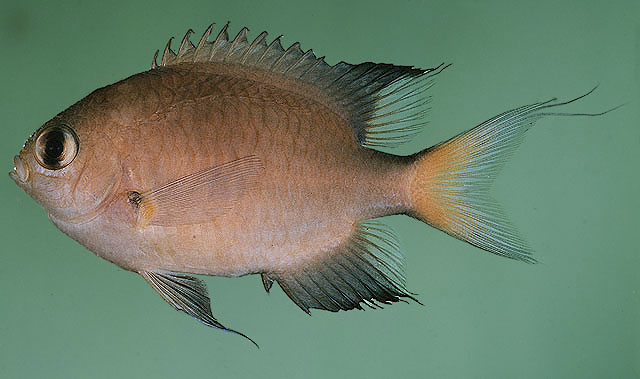| Pomacentridae (Damselfishes), subfamily: Chrominae |
| 9 cm TL (male/unsexed) |
|
reef-associated; marine; depth range 2 - 40 m, non-migratory |
| Eastern Indian Ocean to Western Pacific: Christmas Island and the northwest shelf reefs of Australia in the to Kiribati, north to southern Japan. Recently reported from Tonga (Ref. 53797). |
|
Dorsal spines (total): 12-12; Dorsal soft rays (total): 12-12; Anal spines: 2-2; Anal soft rays: 12-12. Body orangish brown with faint light bluish to lavender iridescence on lower head and thorax; darkly-edged orbit; iris yellowish with a blackish blotch dorsally and ventrally. Eyes large. Preopercular margin smooth. Blackish spot on dorsal and anal fins confined at rear base; upper and lower edges of caudal peduncle and fin blackish; wedge-shaped black spot on pectoral base. With prominent pores of lateralis system on head (Ref. 2693). Body depth 1.7-2.0 in SL (Ref. 90102). |
| Adults inhabit coral rich areas of outer reef passes and slopes. They occur singly or in small groups near the bottom (Ref. 7247). Diurnal species (Ref. 113699). Oviparous, distinct pairing during breeding (Ref. 205). Eggs are demersal and adhere to the substrate (Ref. 205). Males guard and aerate the eggs (Ref. 205). |
|
Least Concern (LC); Date assessed: 16 November 2010 Ref. (130435)
|
| harmless |
Source and more info: www.fishbase.org. For personal, classroom, and other internal use only. Not for publication.

